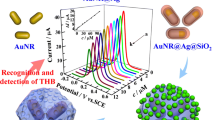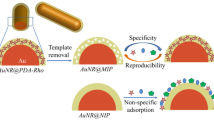Abstract
Poor selectivity and reusability of Au/Ag nanostructures are the main challenges for surface-enhanced Raman spectroscopy (SERS) in real sample detection. Herein, a novel specific and reusable three-dimensional (3D) SERS sensor with dual functions of selective trapping and photocatalytic degradation was designed. Firstly, Au-Ag bimetallic nanoparticles decorated silicon nanowires array (SiNWs-AuAg) were prepared as 3D SERS substrate. Then, silicon-based inorganic-framework molecularly imprinted TiO2 (TiO2@SiMIP) was synthesized and immobilized on SiNWs-AuAg by using rhodamine 6G (R6G) as template molecule. Owing to the excellent SERS performance of SiNWs-AuAg and the specific affinity of TiO2@SiMIP to template molecule, the prepared SERS sensor enables sensitive and selective detection of R6G in food samples with a limit of detection (LOD) of 0.27 nM. In addition, due to the photocatalysis of TiO2 and the stability of silicon-based inorganic framework, the residual templates in TiO2@SiMIP can be completely removed by UV irradiation, and the imprinted cavity of regenerated sensors still maintained good selectivity after regeneration by UV irradiation.
Graphical abstract







Similar content being viewed by others
References
Jiang L, Hassan MM, Ali S, Li H, Sheng R, Chen Q (2021) Evolving trends in SERS-based techniques for food quality and safety: a review. Trends Food Sci Tec 112:225–240
Wei H, Abtahi SMH, Vikesland PJ (2015) Plasmonic colorimetric and SERS sensors for environmental analysis. Environ Sci Nano 2(2):120–135
Moisoiu V, Iancu SD, Stefancu A, Moisoiu T, Pardini B, Dragomir MP, Crisan N, Avram L, Crisan D, Andras I (2021) SERS liquid biopsy: an emerging tool for medical diagnosis. Colloid Surf B 208:112064
Tong L, Xu H, Käll M (2014) Nanogaps for SERS applications. MRS Bull 39(2):163–168
Willets KA (2014) Super-resolution imaging of SERS hot spots. Chem Soc Rev 43(11):3854–3864
Stranahan SM, Willets KA (2010) Super-resolution Optical imaging of single-molecule SERS hot spots. Nano Lett 10(9):3777–3784
Li J, Yan H, Tan X, Lu Z, Han H (2019) Cauliflower-inspired 3D SERS substrate for multiple mycotoxins detection. Anal Chem 91(6):3885–3892
Wu J, Du Y, Wang C, Bai S, Zhang T, Chen T, Hu A (2019) Reusable and long-life 3D Ag nanoparticles coated Si nanowire array as sensitive SERS substrate. Appl Surf Sci 494:583–590
Fang H, Zhang CX, Liu L, Zhao YM, Xu HJ (2015) Recyclable three-dimensional Ag nanoparticle-decorated TiO2 nanorod arrays for surface-enhanced Raman scattering. Biosens Bioelectron 64:434–441
Lu Z, Wei W, Yang J, Xu Q, Hu X-Y (2022) Improved SERS performance of a silver triangular nanoparticle/TiO2 nanoarray heterostructure and its application for food additive detection. New J Chem 46(15):7070–7077
Liao W, Liu K, Chen Y, Hu J, Gan Y (2021) Au–Ag bimetallic nanoparticles decorated silicon nanowires with fixed and dynamic hot spots for ultrasensitive 3D SERS sensing. J Alloys Compd 868:159136
Yang Y, Li Y, Zhai W, Li X, Li D, Lin H, Han S (2021) Electrokinetic preseparation and molecularly imprinted trapping for highly selective SERS detection of charged phthalate plasticizers. Anal Chem 93(2):946–955
Szlag VM, Rodriguez RS, He J, Hudson-Smith N, Kang H, Le N, Reineke TM, Haynes CL (2018) Molecular affinity agents for intrinsic surface-enhanced Raman scattering (SERS) sensors. ACS Appl Mater Inter 10(38):31825–31844
Zhou T, Ding L, Che G, Jiang W, Sang L (2019) Recent advances and trends of molecularly imprinted polymers for specific recognition in aqueous matrix: preparation and application in sample pretreatment. TrAC, Trends Anal Chem 114:11–28
Chen L, Wang X, Lu W, Wu X, Li J (2016) Molecular imprinting: perspectives and applications. Chem Soc Rev 45(8):2137–2211
Guo X, Li J, Arabi M, Wang X, Wang Y, Chen L (2020) Molecular-imprinting-based surface-enhanced raman scattering sensors. ACS Sensors 5(3):601–619
Wang J, Li J, Zeng C, Qu Q, Wang M, Qi W, Su R, He Z (2020) Sandwich-like sensor for the highly specific and reproducible detection of rhodamine 6G on a surface-enhanced raman scattering platform. ACS Appl Mater Inter 12(4):4699–4706
Ma J, Yan M, Feng G, Ying Y, Chen G, Shao Y, She Y, Wang M, Sun J, Zheng L, Wang J, Abd El-Aty AM (2021) An overview on molecular imprinted polymers combined with surface-enhanced Raman spectroscopy chemical sensors toward analytical applications. Talanta 225:122031
Li H, Ren C, Meng J, Gao Y, Ren T, Li Y, Qiao Y, Liu C, Che G (2020) Multifunction sandwich composite SERS imprinted sensor based on ZnO/GO/Ag for selective detection of cyfluthrin in river. ChemistrySelect 5(21):6475–6481
Ren X, Yang L, Li Y, Li X (2021) Design and synthesis of a sandwiched silver microsphere/TiO2 nanoparticles/molecular imprinted polymers structure for suppressing background noise interference in high sensitivity surface-enhanced Raman scattering detection. Appl Surf Sci 544:148879
Li H, Wang Y, Li Y, Zhang J, Qiao Y, Wang Q, Che G (2020) Fabrication of pollutant-resistance SERS imprinted sensors based on SiO2@TiO2@Ag composites for selective detection of pyrethroids in water. J Phys Chem Solids 138:109254
Luo X, Deng F, Min L, Luo S, Guo B, Zeng G, Au C (2013) Facile one-step synthesis of inorganic-framework molecularly imprinted TiO2/WO3 nanocomposite and its molecular recognitive photocatalytic degradation of target contaminant. Environ Sci Technol 47(13):7404–7412
Xu S, Lu H, Chen L, Wang X (2014) Molecularly imprinted TiO2 hybridized magnetic Fe3O4 nanoparticles for selective photocatalytic degradation and removal of estrone. RSC Adv 4(85):45266–45274
Wu Y, Dong Y, Xia X, Liu X, Li H (2016) Facile synthesis of N–F codoped and molecularly imprinted TiO2 for enhancing photocatalytic degradation of target contaminants. Appl Surf Sci 364:829–836
Deng F, Liu Y, Luo X, Wu S, Luo S, Au C, Qi R (2014) Sol-hydrothermal synthesis of inorganic-framework molecularly imprinted TiO2/SiO2 nanocomposite and its preferential photocatalytic degradation towards target contaminant. J Hazard Mater 278:108–115
Shen X, Zhu L, Huang C, Tang H, Yu Z, Deng F (2009) Inorganic molecular imprinted titanium dioxide photocatalyst: synthesis, characterization and its application for efficient and selective degradation of phthalate esters. J Mater Chem 19(27):4843–4851
Pei D-N, Zhang A-Y, Pan X-Q, Si Y, Yu H-Q (2018) Electrochemical sensing of bisphenol A on facet-tailored TiO2 single crystals engineered by inorganic-framework molecular imprinting sites. Anal Chem 90(5):3165–3173
Lofgreen JE, Ozin GA (2014) Controlling morphology and porosity to improve performance of molecularly imprinted sol–gel silica. Chem Soc Rev 43(3):911–933
Yuan L, Han C, Pagliaro M, Xu Y-J (2016) Origin of enhancing the photocatalytic performance of TiO2 for artificial photoreduction of CO2 through a SiO2 coating strategy. J Phys Chem C 120(1):265–273
Moein MM, Abdel-Rehim A, Abdel-Rehim M (2019) Recent applications of molecularly imprinted sol-gel methodology in sample preparation. Molecules 24(16):2889
Liao W, Lin Q, Xu Y, Yang E, Duan Y (2019) Preparation of Au@Ag core–shell nanoparticle decorated silicon nanowires for bacterial capture and sensing combined with laser induced breakdown spectroscopy and surface-enhanced Raman spectroscopy. Nanoscale 11(12):5346–5354
Yang E, Liao W, Lin Q, An H, Li D, Wei F, Duan Y (2020) Quantitative analysis of salmonella typhimurium based on elemental-tags laser-induced breakdown spectroscopy. Anal Chem 92(12):8090–8096
Sasirekha N, Basha SJS, Shanthi K (2006) Photocatalytic performance of Ru doped anatase mounted on silica for reduction of carbon dioxide. Appl Catal B Environ 62(1):169–180
Purcar V, Rădiţoiu V, Dumitru A, Nicolae C-A, Frone AN, Anastasescu M, Rădiţoiu A, Raduly MF, Gabor RA, Căprărescu S (2019) Antireflective coating based on TiO2 nanoparticles modified with coupling agents via acid-catalyzed sol-gel method. Appl Surf Sci 487:819–824
Thamaphat K, Limsuwan P, Ngotawornchai B (2008) Phase characterization of TiO2 powder by XRD and TEM. Agric Nat Resour 42(5):357–361
Wu L, Buchholz D, Bresser D, Gomes Chagas L, Passerini S (2014) Anatase TiO2 nanoparticles for high power sodium-ion anodes. J Power Sources 251:379–385
Karabel Ocal S, Patarroyo J, Kiremitler NB, Pekdemir S, Puntes VF, Onses MS (2018) Plasmonic assemblies of gold nanorods on nanoscale patterns of poly(ethylene glycol): application in surface-enhanced Raman spectroscopy. J Colloid Interface Sci 532:449–455
Li H, Jiang J, Wang Z, Wang X, Liu X, Yan Y, Li C (2017) A high performance and highly-controllable core-shell imprinted sensor based on the surface-enhanced Raman scattering for detection of R6G in water. J Colloid Interface Sci 501:86–93
Chao Y, Pang J, Bai Y, Wu P, Luo J, He J, Jin Y, Li X, Xiong J, Li H, Zhu W (2020) Graphene-like BN@SiO2 nanocomposites as efficient sorbents for solid-phase extraction of Rhodamine B and Rhodamine 6G from food samples. Food Chem 320:126666
Oplatowska-Stachowiak M, Elliott CT (2017) Food colors: existing and emerging food safety concerns. Crit Rev Food Sci Nutr 57(3):524–548
Rapid alert system for food and feed. https://webgate.ec.europa.eu/rasff-window/screen/search.
Funding
This work was supported by financial support from the Second Tibetan Plateau Scientific Expedition and Research Program (STEP) (No. 2019QZKK0201), the Opening Research Foundation of Key Laboratory of Coarse Cereal Processing of Ministry of Agriculture and Rural Affair (No. 2020CC004), the Key Laboratory of Medicinal and Edible Plant Resources Development of Sichuan Education Department (No. 10Y202103), and the Introduction of Talent Research Start-Up Fund of Chengdu University (No. 2081920038).
Author information
Authors and Affiliations
Corresponding authors
Ethics declarations
Conflict of interest
The authors declare no competing interests.
Additional information
Publisher’s note
Springer Nature remains neutral with regard to jurisdictional claims in published maps and institutional affiliations.
Supplementary information
ESM 1
(DOCX 2281 kb)
Rights and permissions
Springer Nature or its licensor (e.g. a society or other partner) holds exclusive rights to this article under a publishing agreement with the author(s) or other rightsholder(s); author self-archiving of the accepted manuscript version of this article is solely governed by the terms of such publishing agreement and applicable law.
About this article
Cite this article
Liao, W., Wang, Q., Hao, J. et al. Molecularly imprinted 3D SERS sensor with inorganic frameworks for specific and recyclable SERS sensing application. Microchim Acta 190, 50 (2023). https://doi.org/10.1007/s00604-023-05631-3
Received:
Accepted:
Published:
DOI: https://doi.org/10.1007/s00604-023-05631-3




